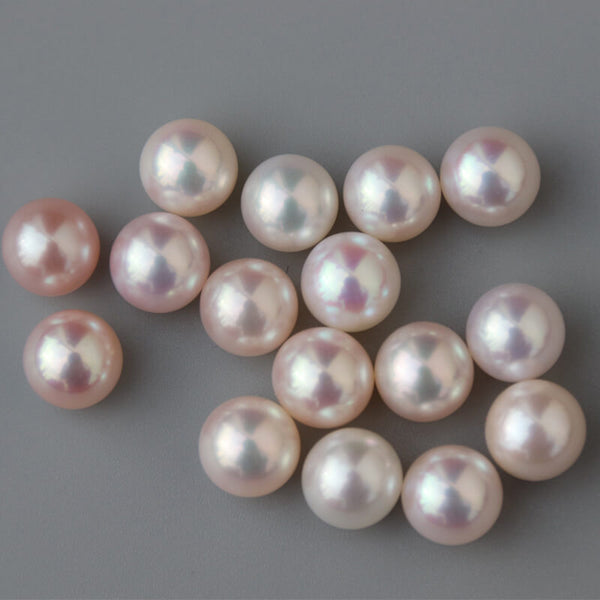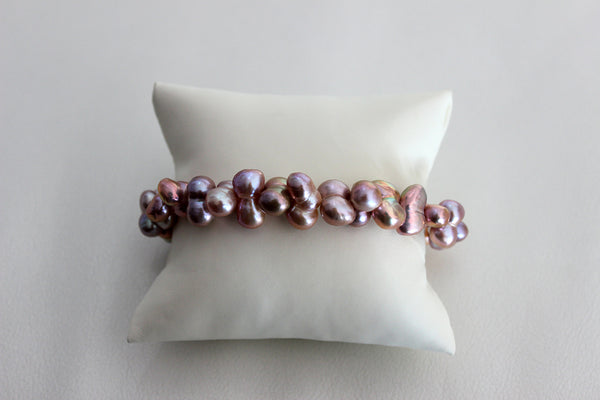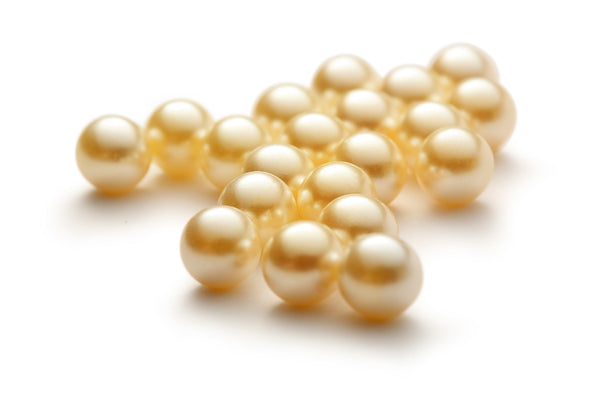Types of Pearls

Pearl types can generally be divided into two major categories: those produced in fresh water and those grown in salt water.
Freshwater pearls are commonly grown inside the Hyriopsis cumingii mollusc, also known as the “triangle mussel” in rivers, lakes or ponds. The history of freshwater pearl cultivation can be traced back to the 13th century when the earliest blister pearls were cultured in China. However, it wasn’t until the mid 1990s that the Chinese started producing higher quality pearls. Most of the freshwater pearls seen today are cultured in China although a very small percentage of them are also grown in Japan and the US. The most common pearl-growth period for freshwater pearls is three to five years, although some may take up to seven years to grow.

Unlike saltwater cultured pearls, freshwater cultured pearls do not normally contain bead nuclei and therefore most of them are made of entirely solid nacre. This distinction makes freshwater pearls more durable than saltwater pearls. In addition, freshwater pearls rarely come in perfect round shapes. In fact, only about 2% of all freshwater pearls are round or near-round. Most of them are in irregular shapes, known as baroque or semi-baroque shapes. This interesting feature makes freshwater pearl jewellery very exciting and fun to wear.
Freshwater pearls also come in a wide variety of natural colours. They include white, cream, orange, pink, and lavender. Freshwater pearls are also known to display strong orient. Orient is an iridescent rainbow effect caused by light diffraction just beneath the pearl surface.

It’s important to note, however, freshwater pearls with lower quality are often dyed in intensive colours. Colours such as black and chocolate brown shades in freshwater pearls are not natural and are the result of colour treatment.
With the advancement of the cultivation techniques over the last decade, Chinese pearl farmers have been able to produce large, round freshwater pearls with mirror-like lustre that can rival the finest Akoya, South Sea and Tahitian pearls. Yet, these top quality gems make up less than 1% of total production.
Akoya pearls are the traditional pearls that people usually think of. Typically, they are perfectly round, white and highly lustrous. They were the first round cultured pearls marketed to the world by Mikimoto at the beginning of the twentieth century.
Akoya pearls, named after the mollusc species in which they grow, are saltwater cultured pearls. Its scientific name is Pinctada fucata martensii. While famously indigenous to the Japanese waters, the akoyas also grow in China, Southeast Asia and the Persian Gulf.Most Akoya pearls are round or near-round, ranging from 6 to 8mm in diameter on average. Although most people picture Akoya pearls as a white strand, they do come in a variety of natural colours. Their body colours include white, cream, and pink, often accompanied with a rose or ivory overtone.The most distinctive feature that makes Akoya pearls stand out from the other pearl types is its high lustre. A top quality Akoya pearl typically exhibits a lustrous surface with a mirror-like reflection. Nacre quality is one of the important factors that determine a pearl’s lustre.

Due to the cooler water temperature, the layers of aragonite platelets in Japanese Akoya pearls are normally formed tighter than those formed in warm-water pearls. As a result, top quality Japanese Akoya pearls often display a very high lustre.It is important to bear in mind, however, that the health of the mollusc and its environment, is also crucial to produce a pearl with beautiful lustre and shine. Any change in the weather, nutrient level in the water and pollutions will inevitably affect pearl cultivation.With their beautiful shine and timeless elegance, Akoya pearls continue to be a long-term favourite among brides and designers. From a well-matched strand to a pair of earrings, Akoya pearls are the perfect accessories for weddings, or any occasions to achieve a classic and elegant look.
Tahitian pearls, renowned for their exotic look, have changed our traditional image of pearls since they were first introduced to the market in the mid-1970. They grow in the black-lipped mollusc called Pinctada margaritifera cumingii, and are native to French Polynesia.

Tahitian pearls are often known as the “black pearls” but this name is misleading. Tahitian pearls are not entirely black. In fact, they offer the widest range of natural colours ever seen in the market. They come in shades of grey, black, or brown and they can have blue to green, purple, yellowish green or pink overtones. In the pearl industry, the term “pistachio”, “aubergine”, or “peacock” is often used to vividly describe the Tahitian pearl colour.While around 40% of Tahitian cultured pearls are spherical, many are circled or baroque shaped. Most Tahitian pearls measure between 9 and 14mm but the average size is around 9.5mm.Treasured for their rarity and their intriguing beauty, fine quality Tahitian pearls display excellent lustre. Sometimes, the lustre can be so high that it almost reaches a metallic sheen. This unique feature, together with their fascinating colours, makes Tahitian pearls very valuable and exciting to wear.
South Sea pearls, among all other pearl types, are the largest and most valuable cultured pearls in the market. They grow in Pinctada maxima, the saltwater mollusc that is indigenous to the warm waters of northern Australia, Indonesia, the Philippines and Burma.

Compared to the molluscs that produce Akoya and Tahitian pearls, P. maxima is significantly larger and can grow up to 12 inches in diameter. There are two different types of P. maxima, the silver-lipped and the gold lipped. The silver-lipped type is abundant off the coast of North Western Australia, mainly yielding white to silver South Sea pearls. The gold-lipped type produces mostly yellow to golden coloured pearls, and is found in the Philippines and Indonesia.
In general, South Sea pearls measure between 8 to 20mm in diameter, with an average size being 13mm. Unlike Akoya and Tahitian pearls, South Sea pearls have a satiny lustre that is softer. Due to the warm waters and longer growth period, they also have exceptionally thick nacre, resulting in a unique lustrous glow.Interestingly, South Sea pearls are not all white or golden. In fact, they exhibit a wide range of colours including cream, silver, yellow, and golden. In addition, they display various overtones including pink, green and blue.Known for their extraordinary beauty and large sizes, South Sea pearls are considered by many the most luxurious of all pearls.
Conch Pearls and Melo melo Pearls
All of the different pearl types described above are produced by bivalves, the type of molluscs that has two shells joined by a hinge. Univalve molluscs such as conches and Melo melo snails have one shell and no hinge. Although the pearls they produce don't display the pearly lustre of true pearls, both conch and Melo melo pearls are extremely rare and valuable. Natural pearls are found in these univalves when they're harvested for food.
Conch pearls are found at the Caribbean Sea and a small adjacent area of the Atlantic Ocean. They are usually small and rarely round. Their colours range from pink, brown, yellow to white. Pink conch pearls with flame structure usually command an extraordinarily high price.
Melo melo pearls (or melo pearls) are produced by the same name sea snail that is indigenous to the waters of Southern Asia. The shape of its shell is like a scroll. Melo pearls are often spherical and they can be very large. The size of 20 to 30mm in diameter is not uncommon among these rare gems. The shades of Melo pearls include light tan and brown with the most prized colour being orange.





